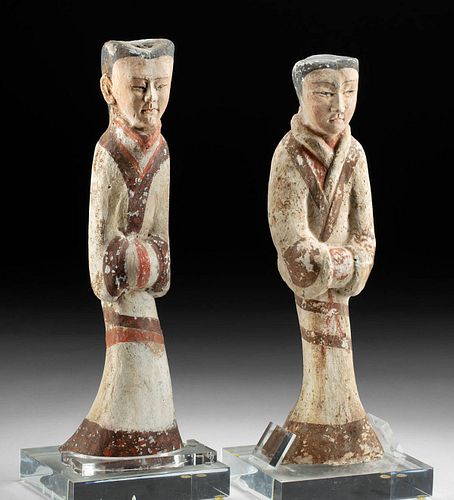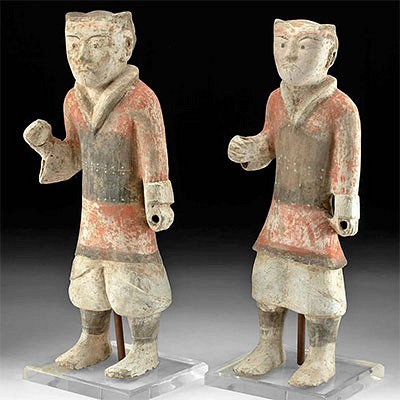Chinese Han Dynasty Mingqi Tomb Figures (pr), TL Tested
Lot 67a
About Seller
Artemis Gallery
686 S Taylor Ave, Ste 106
Louisville, CO 80027
United States
Selling antiquities, ancient and ethnographic art online since 1993, Artemis Gallery specializes in Classical Antiquities (Egyptian, Greek, Roman, Near Eastern), Asian, Pre-Columbian, African / Tribal / Oceanographic art. Our extensive inventory includes pottery, stone, metal, wood, glass and textil...Read more
Categories
Estimate:
$5,000 - $7,500
Absentee vs Live bid
Two ways to bid:
- Leave a max absentee bid and the platform will bid on your behalf up to your maximum bid during the live auction.
- Bid live during the auction and your bids will be submitted real-time to the auctioneer.
Bid Increments
| Price | Bid Increment |
|---|---|
| $0 | $25 |
| $300 | $50 |
| $1,000 | $100 |
| $2,000 | $250 |
| $5,000 | $500 |
| $10,000 | $1,000 |
| $20,000 | $2,500 |
| $50,000 | $5,000 |
| $100,000 | $10,000 |
| $200,000 | $20,000 |
About Auction
By Artemis Gallery
May 25, 2023
Set Reminder
2023-05-25 10:00:00
2023-05-25 10:00:00
America/New_York
Bidsquare
Bidsquare : ON-SALE! Antiquities, Pre-Columbian, Ethno, Fine Art
https://www.bidsquare.com/auctions/artemis-gallery/on-sale-antiquities-pre-columbian-ethno-fine-art-12860
ON-SALE Antiquities, Pre-Columbian, Ethno, More! Artemis Gallery info@artemisgallery.com
ON-SALE Antiquities, Pre-Columbian, Ethno, More! Artemis Gallery info@artemisgallery.com
- Lot Description
East Asia, China, Han Dynasty, ca. 206 BCE to 220 CE. A pair of tall mold made pottery figures of known as a mingqi or "spirit utensil" created to care for a deceased individual of high status in the tomb. Both are stylized and shown standing with hands together at waist and displaying slender bodies draped in lengthy, flared robes, representing house attendants or servants to assist the deceased. By recreating the daily life of the Emperor's court or a noble person's world with pottery servants, the deceased could transition into the afterlife with familiar possessions and companions. The Han Dynasty was a period of wealth and stability for China, and the burial places of their rulers reflected this prosperity - inside of burial mounds, hundreds and sometimes thousands of mingqi figures were placed to assist and serve. The need for these pottery figures spawned a huge industry and the remains of workshops have also been found near the burial mounds. Size: 5" L x 3.5" W x 17.3" H (12.7 cm x 8.9 cm x 43.9 cm); 18.75" H (47.6 cm) on included custom stand.
This piece has been tested using thermoluminescence (TL) analysis and has been found to be ancient and of the period stated. A full printed and bound report will accompany the item upon purchase.
Provenance: private Vero Beach, Florida, USA collection, acquired before 2003
All items legal to buy/sell under U.S. Statute covering cultural patrimony Code 2600, CHAPTER 14, and are guaranteed to be as described or your money back.
A Certificate of Authenticity will accompany all winning bids.
We ship worldwide and handle all shipping in-house for your convenience.
#177323Both are repaired and restored with modern pigments added to surfaces. Surface wear and abrasions, chips to high pointed areas. Tl holes on interior of both figures.Condition
- Shipping Info
-
All shipping is handled in-house for your convenience. Your invoice from Artemis Gallery will include shipping calculation instructions. If in doubt, please inquire BEFORE bidding for estimated shipping costs for individual items.
-
- Buyer's Premium



 EUR
EUR CAD
CAD AUD
AUD GBP
GBP MXN
MXN HKD
HKD CNY
CNY MYR
MYR SEK
SEK SGD
SGD CHF
CHF THB
THB













